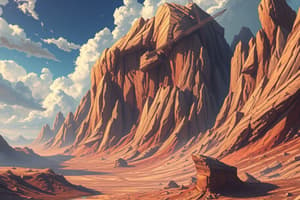Podcast
Questions and Answers
What is the ultimate source of all rocks on the Earth's surface?
What is the ultimate source of all rocks on the Earth's surface?
- Weathered sedimentary rocks
- Metamorphic rocks
- Magma (correct)
- Rock-forming minerals
What happens to sedimentary and metamorphic rocks at the edges of the tectonic plates?
What happens to sedimentary and metamorphic rocks at the edges of the tectonic plates?
- They are weathered and buried
- They are subducted back into the mantle (correct)
- They are broken down into mineral components
- They are transformed into igneous rocks
What is a characteristic of minerals?
What is a characteristic of minerals?
- Heterogeneous composition and highly ordered atomic arrangement
- Naturally occurring homogeneous solid with definite chemical composition and highly ordered atomic arrangement (correct)
- Homogeneous composition and unordered atomic arrangement
- Man-made material with variable chemical composition
What is the term for rocks that are formed from the cooling and solidification of magma?
What is the term for rocks that are formed from the cooling and solidification of magma?
What is the relationship between mineral resources and the history of the biosphere?
What is the relationship between mineral resources and the history of the biosphere?
What is the term for rocks that are formed from the transformation of other rocks by heat, pressure, and chemical change?
What is the term for rocks that are formed from the transformation of other rocks by heat, pressure, and chemical change?
What is the significance of mineral resources in modern society?
What is the significance of mineral resources in modern society?
What is the term for the process of sedimentary rocks being transformed into metamorphic rocks?
What is the term for the process of sedimentary rocks being transformed into metamorphic rocks?
What is the role of rock-forming minerals in the Earth's crust?
What is the role of rock-forming minerals in the Earth's crust?
What determines the characteristic physical properties of minerals?
What determines the characteristic physical properties of minerals?
Flashcards are hidden until you start studying
Study Notes
Rock Formation and Cycle
- The ultimate source of all rocks on Earth's surface is magma, making igneous rocks the primary rocks.
- Igneous rocks can be weathered and converted into sedimentary rocks or transformed into metamorphic rocks by heat, pressure, and chemical change.
- Sedimentary and metamorphic rocks can be subducted back into the mantle, melted, and eventually released as magma to form new igneous rocks.
Types of Rocks
- Sedimentary rocks can be transformed into metamorphic rocks by heat, pressure, and chemical change.
- Metamorphic rocks can be weathered, buried, and converted into sedimentary rocks.
Minerals
- A mineral is a naturally occurring homogeneous solid with a definite chemical composition and highly ordered atomic arrangement, usually formed by inorganic processes.
- There are several thousand known mineral species, with about 100 constituting the major mineral components of rocks (rock-forming minerals).
- Minerals are the basic building blocks of the Earth's crust and the main ingredients of all rocks, deposits, and soils.
- Each rock-forming mineral has:
- A definite chemical composition
- A crystal structure
- Characteristic physical properties (e.g., color, hardness, density)
Studying That Suits You
Use AI to generate personalized quizzes and flashcards to suit your learning preferences.




